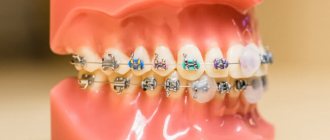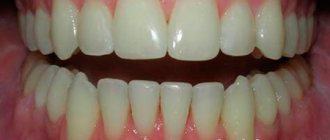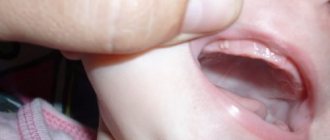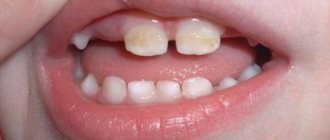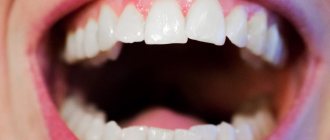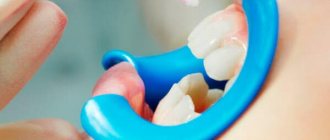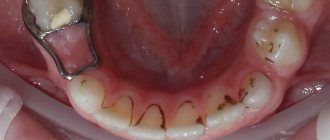Why do children's teeth darken?
The appearance of plaque on a child’s teeth is associated with poor oral hygiene. Due to the lack of systematic cleaning and the use of low-quality paste, microscopic remains of food and bacteria remain on the front and side teeth. Gradually, the milkweeds or indigenous ones turn from light yellow to dark, black.
Other causes of plaque on baby teeth:
- The diet contains foods and drinks with coloring pigments. Plaque in children does not appear slowly, but immediately after eating.
- Caries, especially common in dairymen. A small dark spot appears on the enamel on the inside or in front, gradually turning black and increasing in size.
- Injuries – damage to the vascular bundle. As a result, a hematoma forms in the pulp. Due to the ingress of pigment substances, the tooth becomes black at 3 years or more.
- Problems with the stomach (dysbiosis, bending of the child’s gallbladder) affect the change in shade. The stomach produces secretions that are artificially colored.
- Treatment with medications. For example, tetracycline antibiotics. They accumulate in the enamel tissues of a one-year-old child or older children. After antibiotics, only a dentist can treat.
Another reason is fluorosis. This is a disease that develops due to the use of fluoride in excessive quantities. Black dots begin to appear on the teeth in large numbers. Gradually they merge. A coating forms on the tongue. The clinical picture is complemented by purulent changes in the skeletal and muscular system.
My teeth have turned yellow, could this be due to antibiotics?
Can anyone else suggest a good pediatric dentist in St. Petersburg’s Primorsky district, or Vyborg?
I'll listen. the same crap, after taking an antibiotic all the teeth closer to the gums turned yellow
we had blackening around our gums from antibiotics, the dentist said not to do anything, after a while they went away
Read also: Teeth sensitivity after brushing
Tetracycline antibiotics seem to cause such a reaction. When I drank, my teeth changed color. But I won’t even tell you what to do.
Maybe! a course of fluoride prophylaxis is needed. I work a little far away, in Kupchino
Take your child to the City Dental Center. They have very strong pediatric dentistry. https://www.stomcenter.ru/
one week after antibiotics
and is it still yellow? It passed for us, and quite quickly.
everything just went away!))
Mom won't miss
women on baby.ru
Our pregnancy calendar reveals to you the features of all stages of pregnancy - an extremely important, exciting and new period of your life.
We will tell you what will happen to your future baby and you in each of the forty weeks.
Types of dental plaque in children
Why a child develops plaque can be understood by knowing the main types of this process. This may be an excess of iron or, conversely, a lack of vital components.
Priestley's Raid
The appearance of black dots or stripes is characteristic. They form inside the crowns of milk jugs. Priestley plaque appears less frequently on the outer part of the teeth in children aged 2 and 6 years. The deposits are characterized by a black or dark brown color.
Causes of this condition:
- calcium deficiency in the mother due to an unbalanced diet, frequent stress;
- disturbance of intestinal microflora - occurs not only in infants, but also in children one and a half to two years old;
- chronic gastrointestinal diseases, both acquired and transmitted from parents;
- excess microelements, especially iron;
- bacterial and fungal infections;
- traumatic use of a rubber pacifier;
- worsening of the immune system, leading to the active proliferation of bacteria in the oral cavity.
We recommend reading - Why do you need to treat Priestley's Plaque? Features and danger
Other common causes: caries, predominance of foods containing sugar, too dry climate, hypoplasia of tooth enamel. In the latter case, bacteria multiply very quickly, and an orange plaque may form on the child’s teeth.
Excess iron
Develops with the use of vitamin complexes. Most often these are preparations with manganese gluconate, copper or iron dihydrate. They provoke pigmentation of tissues, and since they are consumed in liquid form, they primarily act on the enamel.
You can avoid the appearance of yellow plaque on your child’s teeth. When taking iron supplements, you must use a drinking straw. It is also necessary that it does not come into contact with the teeth.
Lack of calcium
A deficiency of this element provokes the destruction of enamel. It ceases to resist the unwanted effects of acids and other trace elements. Other consequences of this, leading to a yellowish plaque on permanent teeth:
- increased susceptibility and the appearance of cracks, which are also painted;
- softening of bone tissue, making teeth more vulnerable.
Another consequence is the rapid development of severe caries. Due to calcium deficiency, bacteria settle on the surface of the teeth without any obstacles. As a result, they gradually collapse, and before that they darken. Additionally, a coating appears on the tongue.
Heredity
If parents have gum disease, deep caries or pulpitis, this can be passed on to the child. Treatment of molars is recommended at the stage of pregnancy planning. Without treatment, the child will develop stains and caries, first on the baby teeth, then on the permanent teeth. Close dental control and timely cleaning procedures will be required.
Carious
Children are more susceptible to tooth decay than adults. This happens due to the low density of tissues. Other factors are the peculiarities of the immune system and inadequate cleansing. This is why caries and plaque can spread to all structures in a fairly short period of time.
In such a situation, a dark spot will first appear on the surface of the enamel. Gradually it will turn black and then increase in size. Black plaque on baby teeth will affect not only one, but more. Sometimes caries spreads deeper without external defects. In this case, the incisors become black not on the outside, but on the inside.
Yellow teeth in a child: possible causes and prevention of pigmentation
If you notice that your baby’s teeth have turned yellow, and it doesn’t matter whether they are baby teeth or molars, you need to find out the cause of this event as quickly as possible.
Yellow staining of tooth enamel may indicate both a purely aesthetic reason and the manifestation of a dangerous disease.
Causes of yellowness
Among the possible root causes of enamel pigmentation, dentists most often name the following:
- heredity . If parents are carriers of a yellowish tint of teeth, then most likely the children will not be happy owners of a snow-white smile by nature;
- poor oral hygiene . When a baby brushes his teeth on his own and does not do it very carefully, the appearance of light yellow plaque is inevitable. In the absence of control from mom or dad over this procedure, it is difficult for the children themselves to understand how well the cleansing of food debris has been carried out. Therefore, dentists recommend that parents help their children with oral hygiene until they are 5-8 years old; Advice : Approximately once a year, go to the dental clinic for qualified teeth cleaning.
- thinned tooth enamel . The small thickness of the dental shell, through which dentin is visible, also leads to the appearance of a light straw shade of teeth. Thin enamel may be present from birth, or it may wear away due to significant cleaning efforts. Drinking carbonated drinks in large quantities leads to a decrease in the protective layer of teeth;
- medications . Antibiotics of the tetracycline group can serve as a source of pale amber stains on the teeth of children. A side effect of a woman’s use of tetracycline during pregnancy is precisely the appearance of enamel pigmentation in babies. The use of amoxicillin by the child himself during treatment often leads to a similar result;
- inherited diseases . The share of congenital diseases (amelogenesis imperfecta) in the total number of causes of yellow teeth is very small. And, as a rule, they are not considered as a hidden threat to the health of children.
If the baby does not have confirmation of the above circumstances, the cause of the change in enamel color should be identified by examining the internal organs of the body and the hematopoietic system.
Interesting: the phrase “baby teeth” is attributed to Hippocrates, who was sure that the baby’s first tooth is formed and grows from milk.
Treatment
The correct action in solving the problem of yellow tooth enamel is an urgent visit to the dental clinic. The dentist will identify the source of the impact on the color of the dental shell and prescribe the necessary therapy.
Yellowing of the enamel can be caused by jaundice, inflammation of the adrenal cortex, certain blood diseases, etc. In such cases, treatment begins with treatment of the underlying disease.
The effects of tetracycline are eliminated by irradiating the oral cavity with ultraviolet light. It promotes the decomposition of the antibiotic.
You can correct flaws in oral hygiene by removing tartar and plaque. After which the teeth are coated with fluoride varnish (fluoridation) or silver to fix the result and strengthen the enamel.
The impact of food pigments is neutralized by mechanical cleaning using abrasives or medications.
Hypoplasia (thinning and failure of enamel mineralization) identified during diagnosis is successfully treated by remineralization.
Please note: premature removal of baby teeth can lead to malocclusion in children.
Preventive actions
It is possible to preserve the health and whiteness of your teeth for many years if you follow simple recommendations and certain rules. Preventive actions are as follows:
- From a tender age, your baby should be taught to maintain daily oral hygiene. Parents should make every effort to ensure that the child gets into the habit of brushing his teeth twice a day - in the morning and at night. At 2 years old, a child can already be allowed to brush his teeth independently under adult supervision.
- Children are recommended to use a soft-bristle toothbrush. And under no circumstances should you neglect cleaning your tongue and gums.
- If possible, exclude from your diet foods that can pigment enamel. After each meal of colored and sweet food (juices, jam, tea, etc.), you need to thoroughly clean and rinse your mouth thoroughly.
- It is recommended to systematically, at least once every two to three months, visit a dentist. And immediately go to the dentist if your tooth enamel suddenly turns yellow.
- In the case of weak enamel in a child, it is advisable to undergo remineralization and fluoridation sessions twice a year, upon the direction of a doctor.
- Do not allow anyone to smoke near your toddler.
- Do not let your baby sleep with a bottle, as this leads to bottle caries;
- Minimize your baby's sugar intake and avoid adding sweets to pacifiers.
- You should be very careful when using fluoride-containing foods in your diet. The required amount of fluoride compounds can be obtained by brushing teeth from children's dental paste with fluoride.
- It is very important to provide children with a proper and balanced diet and to include a sufficient amount of calcium-containing foods in the menu.
Compliance with and adherence to the above instructions will help preserve strong enamel and help prevent discoloration in children.
This is important: changes in the color of teeth enamel in children should not be left without parental attention. A timely visit to a dentist will help avoid the development of all kinds of diseases and complications.
Yellowing of the enamel should alert parents. If you do not visit the dentist on time, various diseases may develop. The active phase of the formation of yellow spots on the tooth surface comes at a time when milk teeth fall out and molars are cut.
From this video you will learn how to teach children to brush their teeth:
Source: https://stoma-tolog.com/zhalobyi/zheltye-zuby.html
How to get rid
A dentist can cure this problem after a full examination. To determine this, the doctor uses liquid to indicate dental plaque in children and other means. Additionally, removed milk jugs are examined. Having established the cause of plaque on the teeth, the specialist can:
- Ultrasound procedure. It allows you to painlessly remove hard plaque, soft deposits, and tartar. This prevents damage to the enamel. For infants, one year old and under 2 years of age, the procedure is contraindicated.
- Air Flow. Using a soda-jet mechanism, they get rid of minor plaque from teeth. The disadvantages of this procedure include short duration and weakening of the enamel. Gingival bleeding may occur, so for children it is used in extreme cases.
- Laser cleaning. The most effective method of influencing dental health without damaging the enamel layer and causing pain. Long-term, over four years, preservation of whiteness.
If these methods of combating plaque are not available, you can resort to other measures.
Traditional treatment
The use of these methods should not be the basis of therapy. Traditional treatments should be used only as a supplement to the main course. From the age of 5 years, use one tsp. hydrogen peroxide and soda. They are applied to a cotton pad, after which the teeth are gently massaged. Next, you need to thoroughly rinse your mouth with warm water. The removed disk is not reused.
IMPORTANT! The method can be used once a week, but only under one condition - a positive enamel reaction. Otherwise, treatment is stopped.
Another recipe used at home:
- one tbsp. l. crushed bean peel and burdock root are brewed with boiling water, then infused for several hours;
- take the decoction heated and strained;
- use it three times a day, 60 ml.
This must be done until the plaque is completely removed.
Dr. Komarovsky recommends another effective remedy. This is a homemade tooth powder. It is necessary to spread regular or pink sea salt and sage leaves on foil - two tablespoons each. l. They are placed in a preheated oven - up to 180-200 degrees, for about half an hour.
After the mixture has cooled, it needs to be crushed. The result should be a mass resembling a powder. It is recommended to brush your teeth once a week.
Prevention
Procedures such as fluoridation and remineralization will help prevent the appearance of plaque at 6 years of age or more. Their essence lies in saturating the enamel with those mineral compounds that are absent in it. Treatment complexes must include zinc, calcium, phosphorus, and iron.
Remineralization involves two ways to restore a child’s teeth:
- Application to a previously cleaned surface of applications with a missing mineral, due to which the plaque darkens.
- The introduction of mineral ions into the tooth enamel using special equipment. Devices for phonophoresis or electrophoresis are used.
Another tip on how to remove plaque is fluoridation. Sessions are carried out if the child does not have fluoride and its compounds. In this case, the tissues are intensively saturated with ions of this element. Five sessions are enough.
Video: How to brush your teeth properly
How to treat teeth affected by tetracycline
First of all, patients with such teeth need remineralization therapy. After all, violations are closely related to insufficient mineralization of enamel. Remotherapy is aimed at replenishing the lack of calcium, fluoride and other compounds in the enamel. To remove stains from permanent teeth, whitening is recommended. But if the color is uneven, there is no point in bleaching; it will not be effective if there are horizontal stripes of gray-yellow color. In this case, microprosthetics with veneers is used. If the patient has tetracycline teeth, treatment options may include:
- you can restore a tooth with a composite material using a filling, if the damage is not very large;
- you can restore the affected tissues with the help of veneers;
- orthopedic treatment, that is, installation of crowns. Used for severe lesions.
